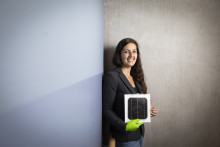MIT Technology Review
MIT Technology Review has been publishing their list of ‘Innovators Under 35’ for the past twenty years. With this list, the media company recognizes ‘exceptionally talented technologists whose work has great potential to transform the world’.
Rebecca Saive, an assistant professor in applied physics at the University of Twente, has been placed on the annual list in the category ‘Inventor’. The scientist was nominated for this global list, because she won its European counterpart last year. She earned her spot thanks to her invention of effectively transparent contacts, which make solar panels cheaper and more efficient.
What does it feel like to be on the MIT’s global list of Innovators Under 35?
Saive: ‘It makes you feel very honoured but also pressured. It is quite funny to see your name on the list that is also full of very famous people like Mark Zuckerberg and Nobel Prize winners. So the pressure is on!’
Do you see yourself as an innovator?
‘Yes, I’d say so. I was awarded this place for my invention and for pushing it to the market. I also have ten (provisional) patents so yes: I think I’m an innovator.’
You were awarded a spot on the MIT Technology Review list thanks to your invention of effectively transparent contacts for solar cells. Can you explain what exactly these contacts do?
‘If you look at solar cells, you will notice these silver lines that crisscross the panels. They are necessary to channel the electricity out of the cell, but essentially they are like the mirror in your bathroom. Mirrors are also made of silver, because it nicely reflects the light and allows you to see your reflection. The silver wires in solar cells do the same thing: they reflect the light away from the cell and back to the sun, which is not desirable. My invention replaces these traditional silver lines with contacts that are triangular. They still reflect the sunlight, but thanks to the shape they reflect it back onto the cell. This idea already existed but the challenge was to scale it up so it could be produced on a large scale. I came up with a novel 3D printing technique that allows that.’
This invention makes the solar cells more efficient, correct? By how much?
‘It makes the cell about 5% more efficient. That might sound like a low number, but it usually takes ten years to achieve this increase in the solar industry. So this is a major improvement.’

You also co-founded start-up ETC Solar. What does the company do?
‘Yes, we started it when I was at Caltech, and so we have offices in California and in Rotterdam where we have a small clean room and labs. I’m officially serving as CTO and supervising the technical development. We don’t make solar cells ourselves, but we are developing the printer to produce the contacts for solar cells. We already have customers who use our product.’
What is your background? Have you always focused on solar cells?
‘I’m originally from Germany and I started working at the UT in 2018. Before that I spent four years at the California Institute of Technology (Caltech). My focus has always been semiconductor physics and solar cells. I’m fascinated by light and how it can be transformed into other energy. The second reason why I focus on solar power is the world’s energy crisis. I’d like to contribute to solving it and I believe that solar power is one of the most important technologies to solve this problem.’
What is your ambition in life? Academia or industry?
‘My ambition is to have the most positive impact I can – through innovation, research and training others. That is why I’m at the university. It gives me the opportunity to train the next generation of innovators.’







